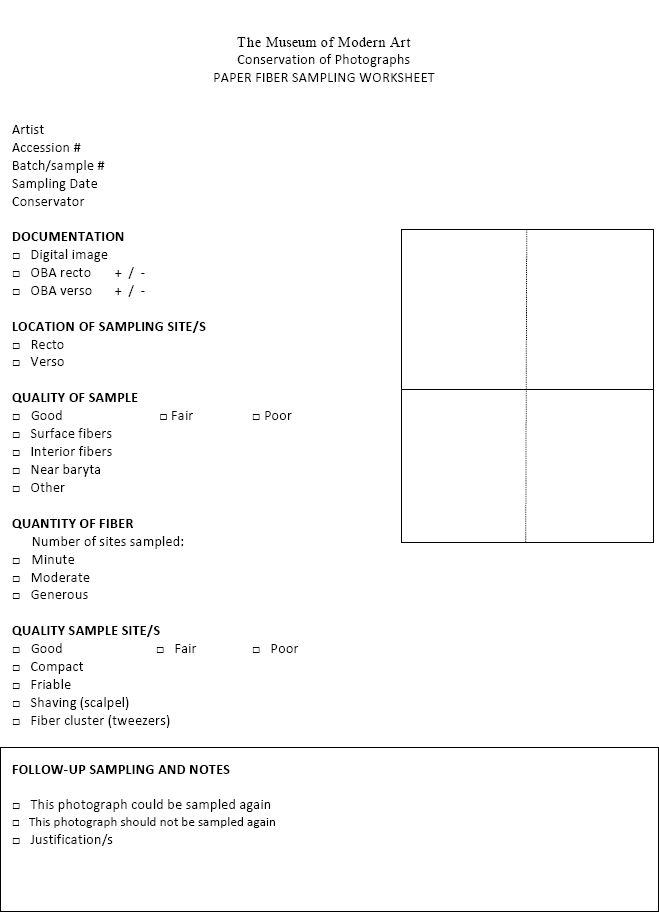
Topics in Photographic Preservation 2009, Volume 13, Article 14 (pp. 83-85)
Presented at the 2009 winter meeting in Tucson, Arizona
The core of many fine art photography collections is the gelatin silver print, the dominant process from mid 1880’s to the present day. A print’s origin can be elementary to understanding the work, its historical context and the creator’s artistic intent. It carries implications for treatment, display and storage and can influence its market value. Tangible information, such as the presence of optical brightening agents, manufacturer back printing, paper fiber analysis, and surface texture characterization can corroborate print dates. Paper fiber analysis and detection of optical brighteners were pivotal in exposing landmark counterfeits (Man Ray in1998 and Lewis Hine in1999), proving that a characterization methodology based on the chemical and physical properties of photographic paper could become a valuable tool for scholarship and authentication.
In 2001 The Museum of Modern Art (MoMA) Conservation Department and Paul Messier embarked on a collaborative study to analyze a selection of papers from the Messier reference collection, identifying fiber content through forensic fiber analysis. Outlining responsible sampling techniques and protocols for works of art and evaluating statistical confidence were central to this study.
Pulp process and fiber species identification for a set of 139 reference gelatin silver papers from the 20th century were obtained. Based on this data, a trial test was carried out to determine the printing date of 20 selected prints with established provenance from the MoMA collection, with good results. The prediction accuracy was further improved by the presence or absence of optical brightening agents (OBAs). The application of statistical protocols, currently under review by MoMA conservation scientist Ana Martins, shows promise of establishing confidence intervals for results and developing an algorithm to automate the dating process based on fiber data.
Placed into a larger context, sampling – the removal of original material – should not be the starting point for dating photographs. The risks and benefits of collecting data must be weighed against information gained. An evaluation of factors is taken into consideration for each work to be sampled. The PAPER FIBER SAMPLING PROTOCOL that follows describes this process. A separate worksheet documents the quality of the sample and the sample site, to be used alongside digital documentation. The number of fibers collected varies from 22 – 300. A generous sample measures 0.3 mm × 4mm while a small sample measures 0.3 × 2 mm.
Paper fiber analysis alone is a powerful tool, but adding qualified data points to the methodology (OBAs, manufacture markings, sizing agents and surface texture) catalyzes credible dating for 20th century photographic prints. This collaborative research will have ramifications in photography scholarship that reach far beyond this one field of inquiry. For fine art collections in particular, these results will yield data that significantly enhances and refines the interpretation of individual works and, more broadly, the stylistic development of artists.
Are the priorities and goals clearly laid out?
Is sampling absolutely essential to investigation?
Are there alternative photographs to sample?
Is the provenance strong or circumstantial?
Have other similar works been examined?
Is this a single object inquiry or part of a larger investigation?
What is the statistical strength of the group and historic time frame?
Assess need vs. the cost of sampling
Can the object be sampled again: is there enough material to retest?
What is the condition of recto?
What is the condition of the edges?
Can the edges be readily sampled? Do I have access to the verso?
Is the mount a barrier or could it contaminate the sample?
If sampling from a damaged edge, can the damage be effectively repaired after sampling, or are fibers critical for structure?
What is the ratio of the object to the sample size?
Is there a coating?
Is the work mounted?
Adapted from the Victoria & Albert Museum Conservation Department Ethics Checklist.
2nd Edition December 2004

Papers presented in Topics in Photographic Preservation, Volume Thirteen have not undergone a formal process of peer review.